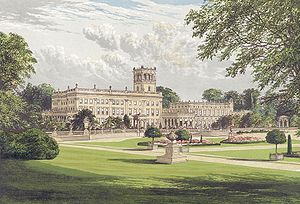The destruction of country houses in 20th-century Britain was the result of a change in social conditions: many country houses of varying architectural merit were demolished by their owners. Collectively termed by several authors "the lost houses", the destruction of these now often-forgotten houses has been described as a cultural tragedy.[2][3]
The British nobility had been demolishing some of their country houses since the 15th century, when comfort replaced fortification as an essential need. For many, demolishing and rebuilding their country homes became a lifelong hobby, in particular during the 18th century when it became fashionable to take the Grand Tour and return home with art treasures, supposedly brought from classical civilizations. During the 19th century, many houses were enlarged to accommodate the increasing numbers of servants needed to create the famed country house lifestyle. Less than a century later, this often meant they were of an unmanageable size.
In the early 20th century, the demolition accelerated, while rebuilding largely ceased. The demolitions were not confined to England, but spread throughout Britain. By the end of the century, even some of the "new" country houses by the architect Edwin Lutyens had been demolished. There were a number of reasons: social, political and, most importantly, financial. In rural areas, the destruction of the country houses and their estates was tantamount to a social revolution. Well into the 20th century, it was common for the local squire to provide large-scale employment, housing, and patronage to the village school, parish church, and a cottage hospital. The "big house" was the bedrock of rural society.[4]
Since 1900, 1,200 country houses have been demolished in England.[5] In Scotland, the figure is proportionally higher. There, 378 architecturally important country houses have been demolished, 200 of these since the end of World War II in 1945.[6][7] Included in the destruction were works by Robert Adam, including Balbardie House and the monumental Hamilton Palace. One firm, Charles Brand of Dundee, demolished at least 56 country houses in Scotland in the 20 years between 1945 and 1965.[8] In England, it has been estimated that one in six of all country houses were demolished during the 20th century.[3]
- ^ Clay, p. 56.
- ^ "Lost houses" has been included in the title of many articles and books on the subject.
- ^ a b Worsley, Giles (15 June 2002). "Country houses: the lost legacy". The Daily Telegraph. Retrieved 9 December 2010.
- ^ Girouard, Mark (1994) [1979]. Life in the English county house. Yale University Press. p. 2. ISBN 978-0-300-05870-3.
- ^ Worsley, p. 7.
- ^ Binney.
- ^ Gow.
- ^ RCAHMS.

